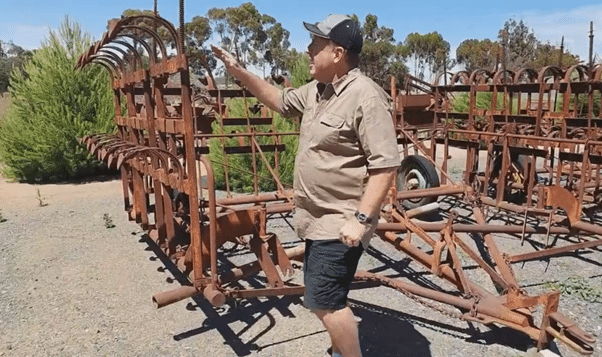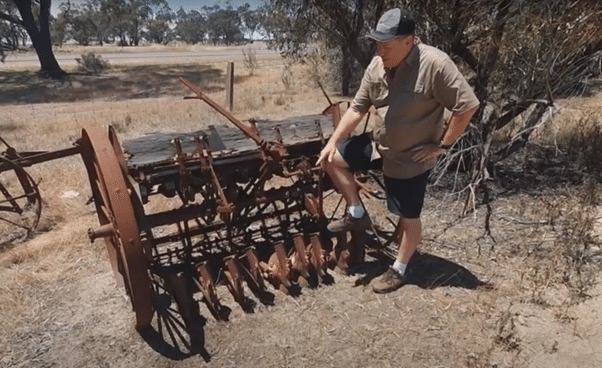Paul Ryan's Wimmera History of Agriculture in Australia tour
G'day, it's Paul Ryan from RYAN NT. Below I take you on a tour of the history of agriculture in Australia and the Wimmera region for tillage and seeding. I've also added how the Ryan products fit into this history.
My History of Agriculture in Australia
A bit about myself, my business RYAN NT (previously known as Ryan Farming Machinery), is in Horsham, Victoria. I am currently running the 2nd generation of Ryan manufacturing. I've always had a passion for designing innovative and new farm machinery.
My father was Austin Ryan, a renowned agricultural inventor who received an OAM in 2001 for services to the rural cropping industry. Austin started the Ryan brand over 50 years ago, and I continue that legacy.
Back in the day, there was much Wimmera manufacturing for tillage and seeding equipment.
The Wimmera had several manufacturers, such as Ryans, Acklands, and Gasons. Eventually, Smales came with their manufacturing too.
I visited the Victoria towns Rupanyup, Beulah, Brim and Warracknabeal on my history tour. I speak about the farm machinery that has stood out to me through the years of mine and my father's service to the agricultural industry.
First stop on my History of Agriculture in Australia tour - Rupanyup
Woods' Farming and Heritage Museum in Rupanyup
I started my tour in Rupanyup at the Woods' Farming and Heritage Museum. The below photo shows a machine that's well over 100 years old.
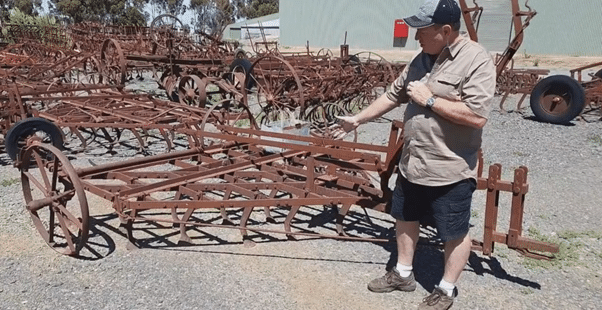
Horse drawn seeder at Woods' Farming and Heritage Museum in Rupanyup
As you can see, this horse-drawn machine used tynes through a gear. There wasn't much spacings and, as you can see, no pneumatic tires.
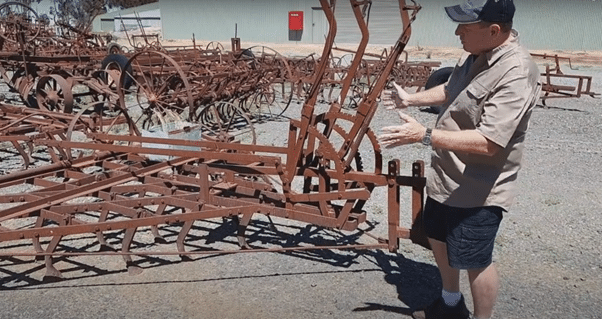
And no doubt a good old Wimmera thing, a scraper for the metal wheel.
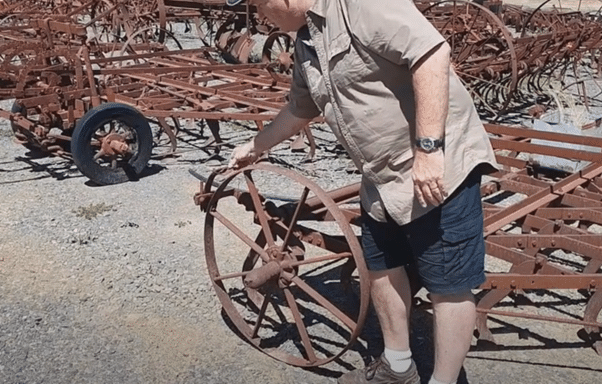
Scraper for metal wheel on horse drawn seeder
The following image shows a good old classic, another horse-drawn machine with a spring tyne on its gear. You can see the seat where the farmer would have sat once, whipping his horse.
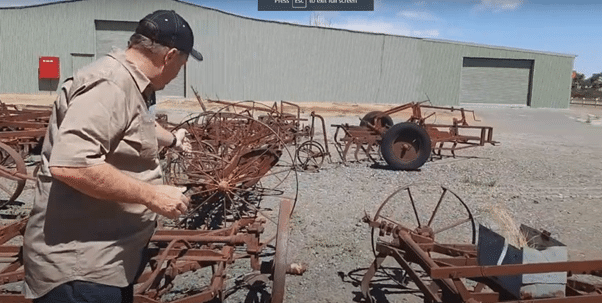
As I wander down through the museum, the machines start to evolve. In the below image, you can see one of the first models to start using pneumatic tyres.

Early seeder using pneumatic tyres
The next machine I walked past was another with a spring tyne system. I couldn't recall which brand it was, but it might be an Acklands.
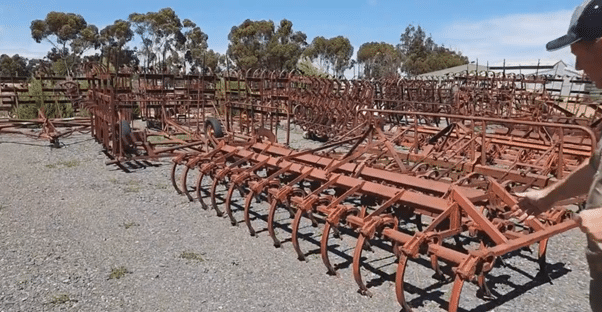
Early spring tyne system
The Acklands Bar
Next up on history of agriculture in Australia tour, we arrive at what they used to call the Ackland bar or Ackie bar. There would be 1000s of these in Australia. The bar had a light frame and a typical old wide point for cultivation and cutting weeds. It was also only a 2 row cultivator with pneumatic tyres.
Farmers used no chemicals back in the days when this machine was working in the paddock.

Acklands bar
Next, we have an Ackie bar, made after the previous one mentioned, with the old spring tyne. Like the last Ackie bar, thousands of these would be around Australia.
Next stop on my History of Agriculture in Australia tour - Warracknabeal
Wheatlands Agricultural Museum in Warracknabeal
The next part of my tour had me landing at the Wheatlands Agricultural Museum in Warracknabeal. This museum has many previous seeding and tillage equipment farmers across Australia used back in the day.
The museum in the heart of the Wimmera plains is the perfect spot for my history of agriculture in Australia tour.
Old antique seeder with discs
Something unique at the museum is that it displays an antique machine fitted with discs. The machine highlights that disc seeding has been going on for a long time. You can see the age of the machine by it not having pneumatic tyres.
I would estimate this old girl to be over 100 years old. Further, it had a wooden seed box, and I bet farmers did not spray weeds with chemicals then.
The old yellow model Scaravator
The following machine I arrived at was an old yellow model Scaravator Austin Ryan designed. As the machine evolved, it became known as the Ryan Scaravator. Austin's machine was first invented at the Beulah Ryan farm, 30 kms north of Warracknabeal.
This spring release wideline cultivator was first thought of by Austin Ryan. The Scaravator's was an extension of the old Ackie bar with the spring tyne and the Shearer with the spring tyne fieldspan.
Its secret was Austin's unique features, including a patented centre pivot to flex into crab and melon holes, and gilgais.
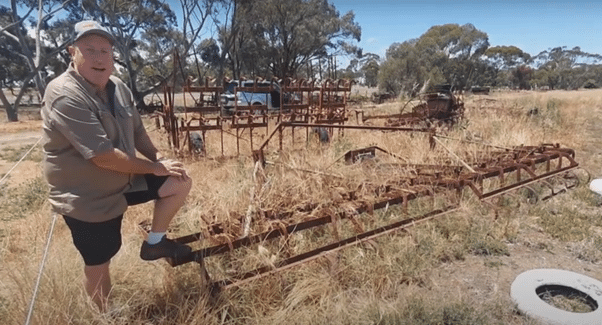
Old yellow model scaravator with middle pivot point
In front of the Scaravator was an Ackie bar with no pivot in the middle, unlike the Scaravator. The pivot point meant you could have a wide machine that would go down inside your gilgais.
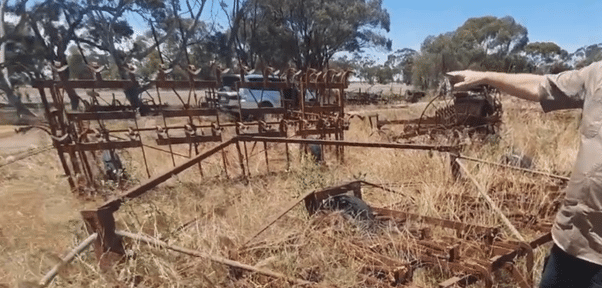
Acklands bar with no middle pivot point
This Scaravator folded and tilt lifted and had push around wings to keep your width down for transport. There were about 20 inches between rows on these old Scaravators.
I moved over to the front of the Scaravator where there was a hydraulic ram. Tractors with hydraulics came out around the late 50s. The hydraulic ram fitted into the Scaravator so you could tilt lift it.
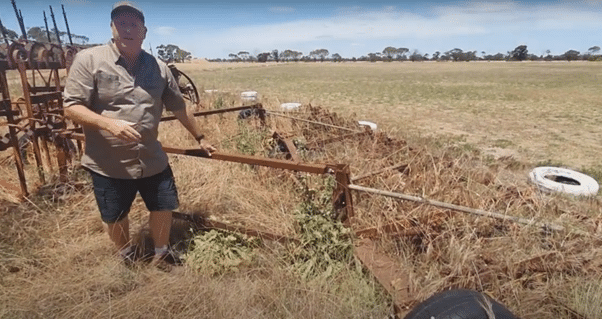
A fun fact for my history of agriculture in Australia tour was how Austin created the Scaravator name. Austin conceived the name from needing a heavy-duty cultivator as only field span cultivators were available.
Austin combined the word scara, short for scarafier and avator short for cultivator to make the word Scaravator.
The first Ryan tyne - A unqiue development in Australian Agriculture History
Austin made a toolbar in the early 1970s for his first straight tyne. The toolbar had straight tynes of various shapes to determine which carried the least trash. The image below shows its little spring that probably wouldn't be a 100-pound breakout.
Sometime after the Scaravator, Austin brought out the Ryan Scaravator in the yellow and green model. The tyne on the Ryan Scaravator had a bend to stop trash building up on it. RYAN NT continues to use that tyne shape today.
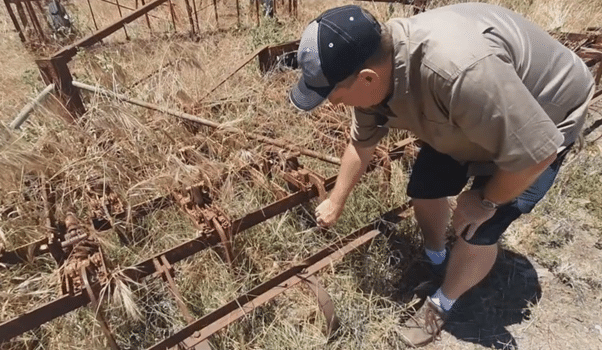
The first Ryan tyne was straight
Stop 3 on my History of Agriculture in Australia tour - Beulah
Max Golder’s experience working on the Ryan Farm
I moved up the highway to where the family farm I grew up on was. This area is where the Ryan Scaravators began. Austin had several staff members, one of whom is with us today and still working in that area, Max Golder. I met with Max so he could tell us how it began, as I was a kid then.

Paul Ryan speaking to Max Golder in Beulah
Max explained that his father was looking for a cultivator better than the Ackland bar. His father had heard that Austin Ryan was making the Bolwell & John's Scaravator. So, Max and his father went to see Austin to discuss it. He said they visited, and Austin had already started making a newer Scaravator, the Ryan Scaravator.
“Austin told us if we helped him build the first one, we could have it on trial. So, we agreed to that and Dad and I started working there and helped him build it,” Max said.
“We first displayed it at the Hopetoun show. There was much interest in the Scaravator after the show.
“Due to this, Austin bought enough steel to build 5 machines. Austin, my father and myself made those five machines all at once.
“Austin had sold the whole lot before they were built.”
Great demand for the Ryan Scaravator
Max and his father ended up with the 5th Scaravator. The intention was for Max and his father to get number 1.
“Other customers got theirs first as they needed it more desperately than they did.
“We sold our Ryan Scaravator, but now I wish we kept it as a bit of a historical thing.
“Austin's first machine went to a farmer Cole Graeme, who wanted it right or wrong.
“We painted the first one blue with white wheels for Austin's town of Beulah.
“People weren't happy about having a Beulah machine, so it went to Australian colours of green with yellow wheels.”

Austin Ryan
Austin had a unique way of working
I remember my mum, Doreen, telling me Austin had a unique way of working.
Max explained that he and his father sometimes would go inside Austin's house for coffee at 10am and Doreen would say “Austin never went to bed last night”.
Max told me when asking Doreen where Austin was, she would say, “He was at the workshop being a “gyro gear loose, muckin around with things and trying to improve the inventions of the time”.
“He was forever doing this,” Max said.
“Austin was constantly changing ideas and developing new ones.
“My father regularly had discussions with Austin.
“Dad told Austin many things wouldn't work. Some of them did, and some of them didn't.”
The Ryan farm workshop
One of my first memories from manufacturing the first Ryan Scaravator was Max's father on an old hacksaw smoking his rollies. Austin started building the Scaravators on the farm in 1972. The Scaravator went from yellow to green and yellow with tension springs.
Max even lived in the old house on the Ryan farm there from about 1973 to 1974. Max explained how his Dad was regularly down in the workshop day and night, including Saturdays and Sundays.
I’d often get roped into whatever was being worked on at the time,” Max recalled.
“Dad had it all worked out.
“He knew how many lengths of steel were required.
“He knew how the cut-offs would fit into a 20-litre drum after being cut off with a hacksaw.
“It was hard work as there were no punching shears.”
From around 1977 to 1978, we moved on to the compression spring model when the yellow airseeder model came out.
The original Ryan workshop
My next stop on my history of agriculture in Australia tour was the workshop on the Ryan farm. The Ryan family started farming here in the late 1800s, and Austin was born here in 1925. This is the workshop Max spoke about, where Austin first started building the Scaravators.
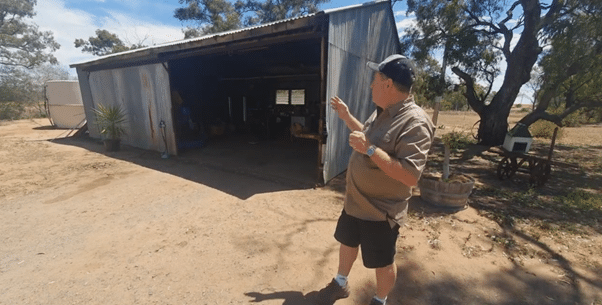
The original Ryan workshop in Beulah
This little 60×20 shed is where Scaravator began in around 1972-1973. The first lot of Scaravators were made here for the first year. I estimated there were probably 50 Scaravators made here before we built the factory in Warracknabeal in 1974.
The workshop on his farm meant that Austin could build and test Scaravators in nearby paddocks. He had about a thousand hectares due east past the shed in the image below to work with.
The 1972 Ryan Scaravator model
My next stop was at an 1972 Ryan Scaravator model, which also had the famous tilt lift.
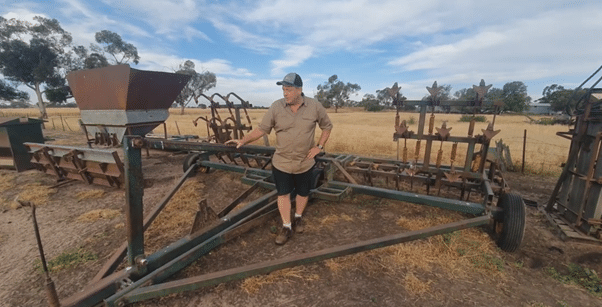
1972 Ryan Scaravator model
We built this model in 1972 with a tension spring until 1977-1978, when the compression model spring came out. I reckon we made a couple of thousand of these in the Warracknabeal factory.
It had several notable design features. As mentioned, one of the features included a tilt lift. Plus, a centre pivot, and the green and yellow Ryan colours.
The Scaravator tilted up, was easy for changing points or clearing trash, and its wings could easily fold. The image above shows a Scaravator with an 18-foot centre.
Final stop on my History of Agriculture in Australia tour - Brim
The Green and Yellow Ryan Scaravator, aka Trashavator
I next arrived at the west off Brim in Victoria, right on the Wimmera Mallee. This location was about 8 or 10 km's west of the original Beulah Ryan farm. The below image shows the 2nd evolution of the Ryan Scaravator in green and yellow colours.
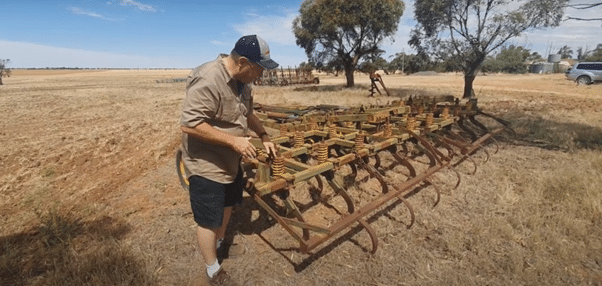
Green and Yellow Ryan Scaravator, the Trashavator
As mentioned earlier, we went from the yellow Scaravator to the yellow and green model Ryan Scaravator. This model came out in 1977 with a compression spring.
Initially, we had a tension spring design, and in 1977, we brought out the vertical spring model. This model had 8-inch spacings to handle more trash. Just like the previous versions, it had the famous tilt lift.
We called it a Trashavator; notably, it had a heavier shank and a scarifier point.
The Trashavator also had a centre pivot so the frame could flex through crab and melon holes, and gilgais.
The old girl in the image has its wings taken off. You can see the pivots where the wings were. The farmer told me he is still using the model in the images.
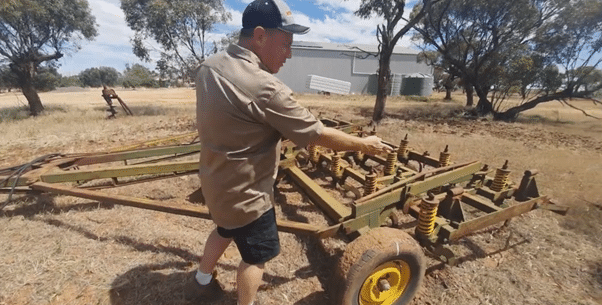
Ryan airdrill 1996 onwards
My final stop at Brim, was at one of the latest Ryan cultivator airseeder models, the Ryan airdrill. I started building these from around the mid-90s to the mid-2000s.
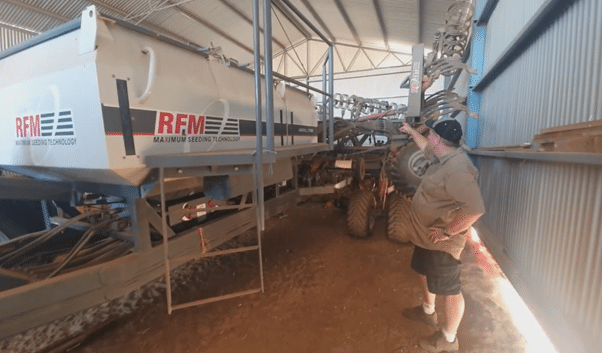
Ryan Airdrill
The concept of the Ryan Airseeder was two rollers that fed into a Venturi system. This model was renowned for a deep banding system and had three hoppers for triple banding.
This model continued with the 3-row design and the well-known Ryan shank. As you can see, the model in the image has the Ryan self-cleaning shank.
The tynes have a double spring (19mm spring with the 13mm spring on the inside), and the tyres are large flotation tyres. Another notable invention from Austin is the self-cleaning coil press harrows on the back of the Airseeder.
The press harrows could level depending on the angle setting. Before Austin passed away, he believed his best invention was the press harrows.
This model was one of the later models before we concentred on retrofit discs, tynes and coil press wheels.
So that's a little history of agriculture in Australia and the Wimmera. I hope you enjoyed some insights into the Ryan developments and innovations over the years.
We would love to hear if you have any Ryan history we could add to this.

